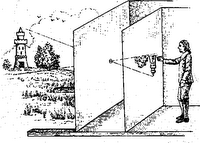
There are some very tall, old-growth fir trees near my house.
Some of these trees are at least 4 feet (1.5 m)
in diameter at their base and must be at least a hundred and fifty years old. Some of them tower 100 to 150 feet high (30-45 m), I would guess.
How tall could they get, assuming they did not eventually succumb to disease or lightning?
Is there any practical limit?
One limiting factor is the difficulty of getting water up to the top to supply growth. Water is heavy.
What does it take to lift water 150 feet or more in the air?
Water gets up the tree partly by capillary action, but also because it is sucked up by a sort of hydraulic vacuum. The needles transpire, giving off water, creating a negative pressure in the capillaries, which are completely closed pipes all the way down to the roots. The negative pressure at the needles literally sucks water out of the ground, right up to the top. That may not be exactly right, but that’s what I believe.
Still, even given that the water transport system is a water-tight vacuum pump, there must be some limit to how much vacuum fir needles can create at the top before they implode from negative pressure. Also, why wouldn’t all the lower down needles sap off the water and reduce the pressure long before the water ever got to the top?
There’s also a structural problem. Wood can only withstand so much compression before it splinters and splits. At some point the weight of the tree would simply crush the wood near the ground and the tree would collapse from its own weight. Why haven’t I ever heard of that happening?
So I just don’t know how tall a tree can get.








